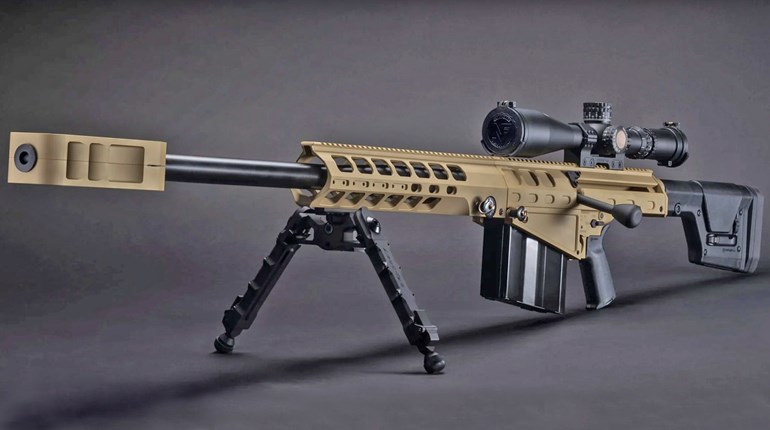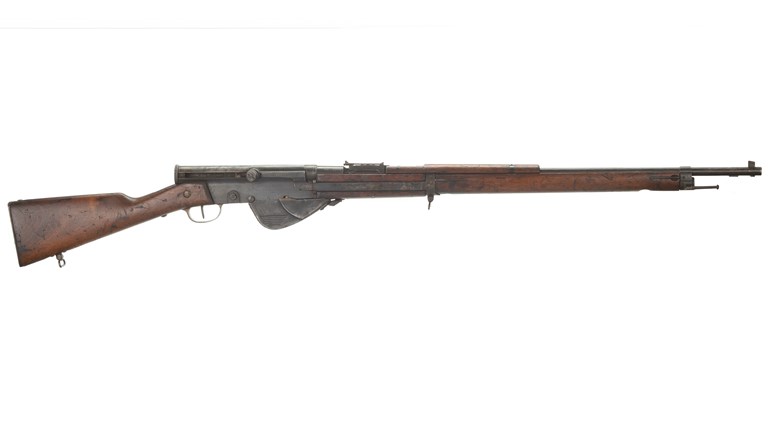

When John Moses Browning designed the .50 BMG cartridge for his Browning Machine Gun prior to World War I, he used the then-new .30-’06 Sprg. cartridge as a model. While it saw use as a sniper cartridge during that “War to End All Wars” and the next three major conflicts involving the United States, the .50 BMG remained relegated to the fabulous “Ma Deuce” M2 machine gun Browning designed around the cartridge—that is until the 1980s, when special .50 BMG long-range rifles began to appear.
Rifles designed around the .50 BMG cartridge quickly caught on, not only for competition, but also within the U.S. military. Today, the .50 BMG cartridge is even more popular in both of these roles, and for good reason—firing projectiles weighing from 650 to 800 grains at velocities from 2,800 to 3,000 fps, it will easily reach out beyond one mile. In fact, Marine sniper Carlos Hathcock recorded a kill at 2,286 meters with a scoped .50 BMG M2HB machine gun manipulated to single fire.
There are now more than 40 rifles chambered for the big .50. Most are single-shot versions or bolt-actions, but there have been a few production self-loading .50 BMG rifles, such as the Barrett Model 82A1/M107 and the Serbu BFG-50A. There was another, which showed promise, but appeared only briefly: the Pauza P-50.

Designed by Robert Pauza in the early 1990s the .50 BMG P-50 operated by short-stroke gas piston and used the tilt (or prop) bolt-locking system similar to that found in the FN-FAL rifle. In fact, although much larger, the tilt bolt and carrier of the P-50 almost mirror those of the FAL. Pauza manufactured about 50 P-50 rifles before the recession of the ’90s forced him to close his business.
After examining an original P-50 rifle several years ago, custom-rifle maker Kerry O’Day of MG Arms in Spring, TX, was impressed with the gun’s design and overall ease of manufacturing. With Pauza’s blessing, O’Day set about redesigning the original P-50 to meet the requirements of today’s market.

Major internal changes to the P-50 included an inertia-driven firing pin and an entirely new fire-control group. The exterior would need a modern, free-floating, railed handguard and a contemporary optics-mounting system. A host of smaller, but vital improvements were also desired, together with a state-of-the-art, match-grade barrel.
While having a full complement of CNC equipment in-house, O’Day turned the design of the overall appearance of the new P-50 over to the father-and-son team of Gary and Justin Schultz. Gary is a CNC specialist with 40 years in the machining industry and Justin is a savvy designer of all things gun. Together, they designed and built the new stock, fore-end and scope mount for the rifle.
The new rifle is, appropriately, called the “Behemoth.” While the Barrett operates by short recoil and the Serbu by direct-gas transfer like the AR-10, the Behemoth is of short-stroke-piston operation, but that’s not the only thing unique about it. The Behemoth is also the first .50 BMG rifle where the operating parts are made entirely of stainless steel. I received a preproduction unit for testing, but the production models are set to be identical to the one I used.

At the end of the Behemoth’s 31-inch, three-groove Pac-Nor Match Grade barrel is a robust muzzle brake consisting of four cross baffles to push the rifle forward as the bullet leaves ahead of the gases. The barrel is made from 400-series stainless steel—the only part of the rifle using this material—and is machined with interrupted fluting.

Secured to the receiver is a 7075T6 aluminum alloy, freefloat handguard with KeyMod mounting holes at three-, six- and nine-o’clock. At the front of the handguard is a three-position gas block, which is pushed in, rotated to the desired adjustment and released to be locked by a spline.
Aside from the barrel, aircraft-alloy handguard, top rail, scope base/receiver cover and adjustable, quick-detachable buttstock, the remainder of the Behemoth is made of 17-4PH aircraft stainless steel (or derivatives thereof) with different heat treatments to prevent galling.

Designed in September 2015, the buttstock used on the Behemoth is specific to the rifle itself, as no other factory stock will work without modification. Made of skeletonized, lightweight alloy, the buttstock is adjustable for height and length-of-pull, and a folding unit is in the works. Currently, however, the Behemoth’s detachable buttstock operates similar to that on the M240 machine gun. The Behemoth accepts most AR-15-style pistol grips.

My sample rifle came with the excellent LCB-3 Tactical Bipod from GG&G. Designed for heavy calibers, this bipod is quickly adjustable, super light yet strong and locks onto a Mil-Spec rail. It can be had with spiked or polymer feet.
Secured by two robust hex bolts, the Behemoth’s reciprocating charging handle can be mounted on either side of the bolt carrier. Located behind the magazine well, the magazine release is ambidextrous and the safety selector located behind the pistol grip is of the crossbolt type. The charging handle can be used to fully chamber a round if necessary and does not lock the bolt back.
Designed for optimum long-range performance, the Behemoth uses a barrel rigidly threaded to the receiver and has proprietary lockwork with a crisp let-off. The optic I selected for the Behemoth was the Nightforce ATACR 5-25x56 mm F1. At the last annual .50 BMG-caliber competition I attended at Whittington Center in Raton, NM, some 95 percent of the shooters were using Nightforce Scopes in the 1,000-yard competition, so I’d wager I made a good choice.


Having kept in contact through design and testing of the Behemoth, I was aware of its sub-MOA performance with high-grade .50 BMG ammunition, such as Hornady’s 750-grain A-Max. This load produced .5-MOA groups from 100 to 400 yards, the longest range available to MG Arms due to heavy flooding in the Houston area. Even G.I. surplus .50 BMG shot around 1 MOA from the Behemoth.
Hoping to test the Behemoth out to 1,000 yards here in Colorado, I was snowed out by the time I received the rifle in early January. However, I look forward to getting in some long-range shooting in the spring. As it was, I was able to shoot the rifle for accuracy from 100 yards with fairly good results in spite of temperatures in the 20s.
At 100 yards, five-shot groups of factory Hornady A-Max .50 BMG hovered around 1.5 inches, and one group at 400 yards of was smaller than 4 inches, but walking through heavy snow limited shooting at that distance. The surplus .50 BMG ball produced accuracy hovering around 2 MOA at 100 yards. This is pretty good performance from mass-produced, military-issue .50 BMG round designed to be used in the M2HB machine gun, and I expect the rifle to do even better in warmer temperatures.

Some failures to eject occurred using the middle setting of the gas adjustment, but turning to the largest position corrected this in the freezing temperatures. Recoil was surprisingly mild, no doubt due largely to the well-designed muzzle brake. Additional recoil mitigation is achieved via the almost constant run-out of the Behemoth’s bolt group, more correctly called “constant recoil,” a term coined by L. James Sullivan, one of the designers of the AR-15, the Stoner 63, the Ruger Mini-14 and the Ultimax.
In constant recoil, the bolt group does not bottom out (or barely does so) at the end of its travel, but stops gradually against the recoil spring. Any bottoming out by the Behemoth’s bolt group is minor and is controlled somewhat by the adjustable gas system. This, in concert with the muzzle brake, results in felt recoil less than that generated by a 12-gauge shotgun.
In summation, the Behemoth is not only unique, but is also quite impressive in quality, as well as precision accuracy, especially for a semi-automatic rifle in this chambering. I would anticipate interest from competitive shooters, law enforcement and the military in this new .50 BMG platform.






































